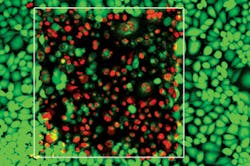Noninvasive photodynamic therapy (PDT) is very precise and boasts no long-term side effects. But because it typically uses visible light, it is normally effective only for the accessible tumors of oral and skin cancers. Now, a new method for activating photodynamic drugs deeper in the body is making other types of tumors accessible to the therapy.1
The technique depends on single-harmonic generation (SHG, also known as frequency-doubling) of infrared light, which travels deeper into tissue than visible light. Collagen, a naturally occurring protein found in connective tissue, has a frequency-doubling effect on the near-infrared (NIR) light used to irradiate a tumor through the skin. Deep in the body, the NIR beams are converted into visible light that activates NIR-sensitive, cancer-fighting drugs that have been injected into the body.
The SHG happens when the natural proteins and lipids interact with the NIR light through four-wave mixing and/or coherent anti-Stokes Raman scattering.
"We expect this will vastly expand the applications for an effective cancer phototherapy that's already in use," said Tymish Ohulchanskyy, research associate professor and deputy director for photomedicine at the University at Buffalo (UB; Buffalo, NY) Institute for Lasers, Photonics and Biophotonics (ILPB).
UB has applied for a patent, and the university's Office of Science, Technology Transfer and Economic Outreach (UB STOR) is discussing potential license agreements with companies interested in commercializing it.
The research is a collaboration between the ILPB, Shenzhen University (China), and Korea University, with which Paras Prasad, Ph.D.—SUNY Distinguished Professor in chemistry, physics, electrical engineering, and medicine at UB, ILPB's executive director, and leader of the work—is affiliated.
1. A. V. Kachynski et al., Nature Photon., doi:10.1038/nphoton.2014.90 (2014).

